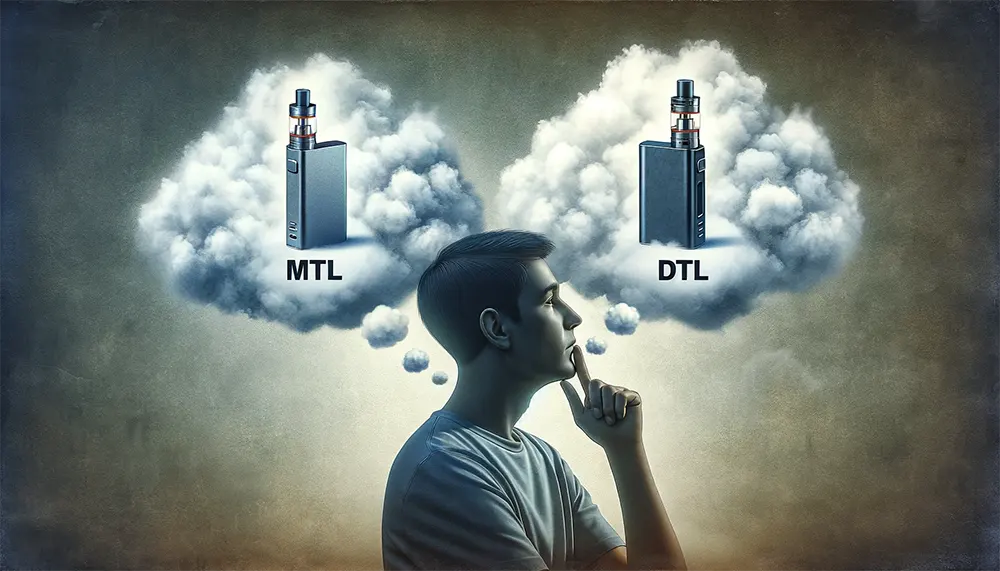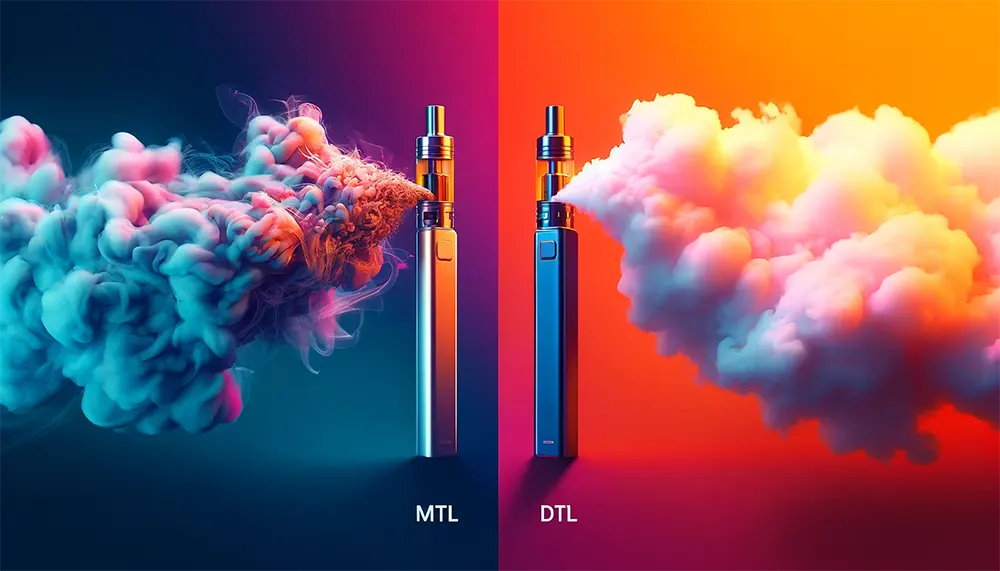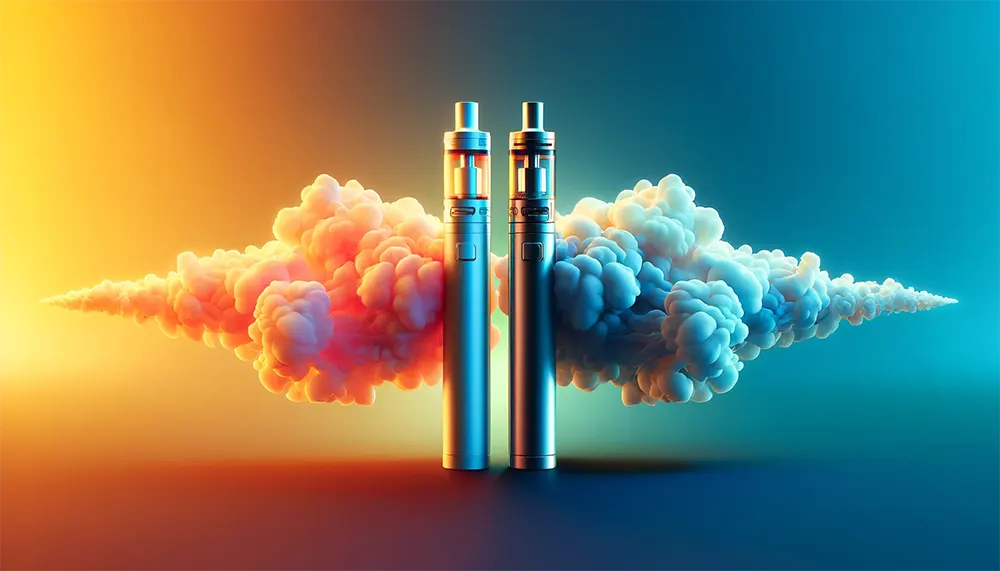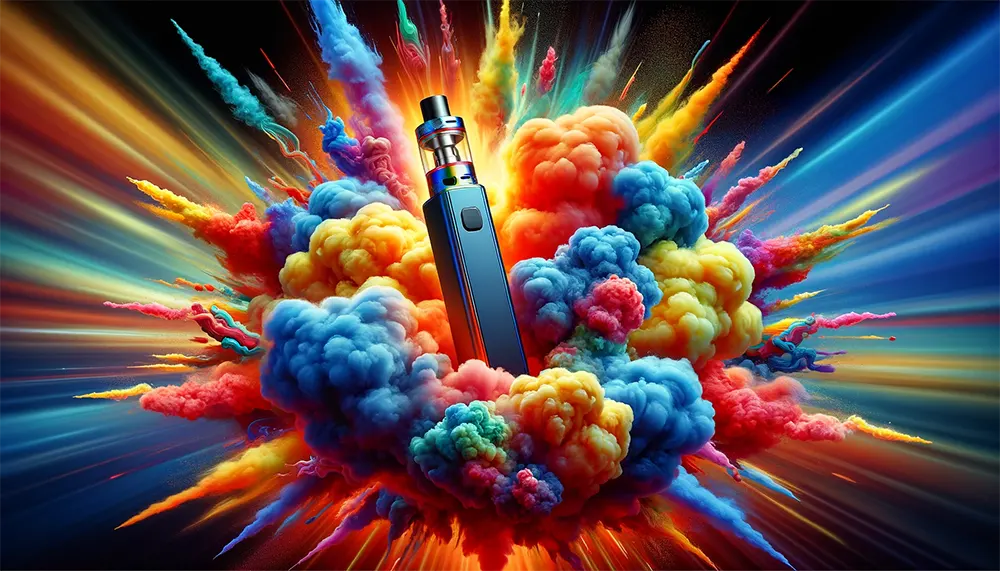Vape Styles Uncovered: Are Disposable Vapes MTL or DTL?
4/2/2024, 5:25:26 PM 2094
In the ever-evolving world of vaping, enthusiasts are constantly bombarded with a plethora of choices. Amidst this variety, a question frequently emerges, sparking debates in forums and social gatherings alike: Are disposable vapes MTL or DTL? Ready to unravel this mystery?
MTL Vape Characteristics
"Mouth-to-Lung (MTL) vape" refers to a vaping style closely mirroring the act of smoking a traditional cigarette. This approach involves a two-step inhalation process where the vapor is first drawn into the mouth and then inhaled into the lungs. MTL vaping is distinguished not only by this inhalation technique but also by its emphasis on enhancing the vaping experience through flavor richness, satisfying throat hit, and effective nicotine delivery. This method appeals to many for its ability to replicate the tactile and sensory aspects of smoking, offering a smoother transition for those looking to switch from smoking to vaping, as well as providing a deeply satisfying experience for long-time vapers who prefer a more controlled and flavorful vape.
1. Tight Draw
This resistance, akin to the resistance felt when smoking a traditional cigarette, is crucial for creating a satisfying throat hit, an aspect especially appreciated by former smokers or those who enjoy the tactile sensation of smoking. MTL devices often feature smaller air intake ports to mimic the airflow restriction of cigarettes, providing a controlled and deliberate vapor intake.
2. Flavor Intensity
MTL vaping shines when it comes to delivering intense and nuanced flavors. Drawing vapor into the mouth before inhaling it into the lungs allows the vaper to savor the e-liquid's flavor complexities fully. This is because the vapor spends more time in the mouth, which gives the taste buds ample opportunity to pick up on the various flavor notes. MTL devices endeavor to optimize the temperature and airflow to enhance the e-liquid's taste rather than focusing on producing large clouds of vapor.
3. Higher Ohm Coils
The coils used in MTL vaping are typically higher in resistance, usually above 1 ohm. These high-ohm devices intend to operate at lower wattages, producing a moderate amount of vapor that can be comfortably held in the mouth before inhalation. It can conserve e-liquid and ensure the vapor is not too hot or overwhelming, making it ideal for the mouth-to-lung technique.
4. Narrower Drip Tip
The narrower drip tip design choice focuses on the vapor flow and enhances the flavor delivery, further mimicking the sensation of smoking a cigarette. The narrower opening also plays a role in controlling the vapor quantity, aligning with the MTL style's preference for flavor over cloud production.
5. Nicotine Efficiency
MTL vaping is highly efficient regarding nicotine delivery, making it a preferred choice for vapers using e-liquids with higher nicotine strengths or nicotine salts, which provide a smooth throat hit and satisfying nicotine rush without the need for large vapor clouds. The slower, more deliberate inhalation process of MTL vaping allows for a more controlled and satisfying nicotine experience, ideal for those managing their nicotine intake.
DTL Vape Characteristics
"Direct-to-Lung (DTL) vape" is a vaping technique where the vapor is inhaled directly into the lungs from the device, without the initial step of holding it in the mouth that's typical of Mouth-to-Lung (MTL) vaping. DTL vaping is characterized by its focus on producing substantial vapor clouds, offering a more pronounced and expansive inhalation experience. This method is preferred by those who enjoy the sensation of a full lung inhale, accompanied by large vapor production, a smoother throat hit compared to MTL vaping, and a unique way of experiencing the e-liquid flavors.
1. Airy Draw
A hallmark of DTL vaping is its notably airy draw, which allows for a smooth, direct inhalation of vapor into the lungs. This is achieved through the design of DTL devices, which feature larger air intake ports and are constructed to facilitate a free-flowing vapor path. The airy draw is essential for generating the voluminous clouds of vapor that DTL is known for, offering a less restricted vaping experience compared to the tighter draw of MTL devices.
2. Cloud Production
DTL vaping is synonymous with impressive cloud production. The direct lung inhalation technique, combined with the design of DTL vape kits, maximizes vapor output, enabling vapers to produce dense, expansive clouds.
3. Lower Ohm Coils
DTL devices typically utilize sub-ohm coils with a resistance lower than 1 ohm, which allows for higher power output and generates more heat, vaporizing e-liquid more efficiently to produce the signature clouds of DTL vaping. Applying sub-ohm coils is integral to achieving the fast, intense vapor delivery that defines the DTL experience.
4. Wider Drip Tip
This design choice better supports smooth direct-to-lung inhalation and contributes to vapor cooling, making the larger volume of inhaled vapor more comfortable. The wider drip tip is a critical feature that complements the overall design philosophy of DTL vaping, focused on maximizing airflow and vapor production.
5. Flavor Experience
The direct lung inhalation spreads the vapor over a larger surface area of the lungs, potentially diluting the flavor intensity compared to MTL vaping. However, the sheer volume of vapor produced in each puff can still deliver robust flavor, especially when using e-liquids designed for sub-ohm vaping, which are often richer and more complex in flavor profiles.
6. Nicotine Consideration
Due to the large volume of vapor inhaled directly into the lungs, DTL vaping typically uses e-liquids with lower nicotine concentrations. The efficient vaporization and inhalation process can deliver a comparable nicotine hit with less concentrated solutions, making high-nicotine e-liquids or nicotine salts less suitable for DTL setups.
7. Vaping Style
DTL vaping reflects a preference for a bold and dynamic vaping experience, highlighting the individual's desire for cloud production and a more pronounced inhalation process, as well as offering an exhilarating experience that emphasizes performance and sensory intensity.
MTL vs. DTL in Disposable Vapes
When it comes to disposable vapes, the distinction between Mouth-to-Lung (MTL) and Direct-to-Lung (DTL) vaping becomes a topic of interest, revealing a clear inclination towards one style over the other.
A: Why Most Disposable Vapes Are Designed for MTL Vaping
1. User Transition and Familiarity
A significant portion of disposable vape users are transitioning from smoking to vaping. MTL vaping’s similarity to cigarette smoking makes it an intuitive first step, which provides a comforting sense of familiarity, reducing the psychological and physical hurdles to switching.
2. Optimized Device Performance
The architectural constraints of disposables — small size, fixed battery, and e-liquid capacity — naturally favor the MTL approach. MTL vaping requires less power, aligning with the lower wattage and battery capacity of disposables, guaranteeing that the device can last longer in terms of battery life and e-liquid consumption, making it an ideal match for the form factor and use-case of disposable vapes.
3. Efficient Nicotine Satisfaction
MTL setups, especially when paired with nicotine salts, offer a concentrated and satisfying nicotine hit. This efficient delivery system is crucial for users seeking a quick nicotine fix without the cloudiness or the overt physicality of DTL vaping.
4. Sustainability and Cost-effectiveness
From an economic and environmental standpoint, the slower consumption rate of e-liquid in MTL devices makes disposables more sustainable. Users can get more puffs out of a single device, reducing waste and extending the time between purchases. This slow consumption is stark against the DTL style, which would rapidly deplete the finite resources of a disposable vape.
B: The Rarity of DTL Disposable Vapes
1. Technical and Design Challenges
The power requirements for heating sub-ohm coils and providing enough airflow for DTL vaping would necessitate larger batteries and more complex air intake mechanisms, complicating the design and potentially increasing the cost and size of a disposable vape.
2. Rapid E-Liquid Depletion
The hallmark of DTL vaping is its dense, voluminous clouds, achieved by consuming a significant amount of e-liquid per puff. In a disposable vape setup, this would lead to rapid e-liquid depletion, dramatically shortening the device's lifespan.
3. Nicotine Content
High-nicotine e-liquids, which are common in disposables for satisfying nicotine delivery, are not well-suited for DTL vaping due to the larger volume of vapor inhaled directly into the lungs. This could lead to an excessive nicotine intake, potentially overwhelming for the user.
4. Consumer Expectations
The disposable vape market is heavily oriented towards simplicity, ease of use, and seamless transition for smokers. The demand for DTL vaping, which is more about cloud production and a sensory-rich experience, tends to come from a niche of vaping enthusiasts. This group often prefers rechargeable, customizable devices that allow for fine-tuning the vaping experience, something disposables cannot offer.
How Do I Know If My Disposable Vape is MTL or DTL?
It might seem challenging at first, especially if the disposable vape doesn't explicitly state its intended use. However, after understanding the core differences between MTL and DTL vaping styles, you can look for specific indicators to help you discern its nature.
Examining the Design and Build
1. Device Airflow System Design:
MTL Devices: Have a tighter airflow, mimicking the draw resistance identical to a traditional cigarette. If your disposable vape requires a bit more effort to inhale and feels restrictive, similar to smoking, it's likely for MTL vaping.
DTL Devices: Implement a much looser, airier draw for a smooth, direct inhale into the lungs without resistance. DTL disposable vapes are rare, but if you feel inhaling from your device is open and effortless, it may be for DTL use.
2. Drip Tip Dimension
MTL Devices: Tend to have narrower, sometimes longer drip tips to focus and cool the vapor for a concentrated flavor hit.
DTL Devices: Though rare, feature a more generous, shorter drip tip for increased airflow and vapor intake.
3. Coil Resistance and Power Output
MTL Devices: Feature higher resistance coils (above 1 ohm), compatible with the lower power output typical of disposable vapes, without generating excessive heat or consuming e-liquid too quickly.
DTL Devices: Utilize lower resistance (sub-ohm) coils requiring more power for generating large vapor clouds. Although rare in disposables due to their power limitations, a disposable vape that focuses on maximizing vapor production might lean towards DTL, albeit within the constraints of disposable device capabilities.
Understanding Performance Characteristics
4. Vapor Temperature and Density
MTL Devices: Produce a warmer vapor due to the restricted airflow, leading to a denser vapor that's rich in flavor. If your disposable vape delivers a warm, flavorful puff that feels substantial in your mouth before inhalation, it leans towards MTL.
DTL Devices: Aim to cool the vapor down due to the larger volume of air mixing with the vapor, resulting in a cooler and more voluminous output.
5. Throat Hit Versus Smooth Inhale
MTL Devices: Replicate the throat hit associated with smoking, offering a sharp, satisfying sensation that mimics inhaling smoke from a cigarette.
DTL Devices: Provide a smoother, less pronounced throat hit due to the direct lung inhalation process, focusing more on the feeling of vapor expansion within the lungs rather than the throat sensation.
Analyzing the E-Liquid Properties
6. PG/VG Ratio
MTL Devices: Often use e-liquids with a higher proportion of propylene glycol (PG) to vegetable glycerin (VG), which provides a stronger throat hit and is more effective at carrying flavor.
DTL Devices: Favor a higher VG content, conducive to producing thicker, more voluminous vapor. While disposables generally don't offer the option to choose e-liquid ratios, those rare DTL-oriented disposables might feature e-liquids that are smoother and designed to produce more vapor.
7. Nicotine Format and Concentration
MTL Devices: Often contain higher nicotine concentrations or are formulated with nicotine salts. If your disposable vape has a high nicotine content (typically over 20 mg/mL) and provides a strong throat hit, it's likely MTL-oriented.
DTL Devices: typically utilize e-liquids with lower nicotine strength to avoid overwhelming nicotine intake. Finding a disposable with low nicotine might suggest a DTL design, though this is less frequent in the disposable market.
In the exploration of "Are disposable vapes MTL or DTL", it's clear that the market predominantly favors MTL configurations. Despite the occasional presence of DTL-style disposables, the overwhelming inclination towards MTL in disposables underscores the aim to provide a straightforward, satisfying vaping experience, particularly for newcomers and those desiring simplicity.
FAQs
Q1. Can a Disposable Vape Be Used for Both MTL and DTL?
Most disposable vapes are designed specifically for either MTL or DTL, not both. MTL disposable devices are typically more compact and offer a tighter draw, miming the sensation of smoking, while DTL devices are larger, offering more airflow for bigger vapor clouds. If you're looking for versatility, check for models with adjustable airflow, though these are rare in disposable vapes.
Q2. Can You DTL (Direct-to-Lung) Disposable Vapes?
While disposable vapes are predominantly designed for MTL vaping, some larger disposable models may offer a looser draw that could work for DTL vaping. However, these are much less common, and most disposable vapes are not optimized for large vapor production and direct lung inhalation.
Q3. Do MTL Disposable Vapes Have Higher Nicotine Content?
Yes, MTL disposable vapes typically come with higher nicotine strengths, ranging from 20mg to 50mg, to provide a stronger throat hit that mimics the experience of smoking. The higher nicotine concentration helps satisfy cravings more effectively for those transitioning from cigarettes. DTL devices, however, are designed for lower nicotine concentrations, often between 3mg to 6mg, as their larger vapor production doesn't require as much nicotine to deliver a satisfying hit.
Q4. Can I Use a Disposable Vape for Cloud Chasing?
Disposable vapes are not built for cloud chasing or DTL vaping, as they typically don't produce the large vapor clouds that DTL vapers enjoy. Their design focuses on flavor, ease of use, and delivering a smooth, satisfying throat hit with a restricted draw. If you're looking for massive clouds, you'll want a sub-ohm tank or an advanced device for DTL vaping.
















